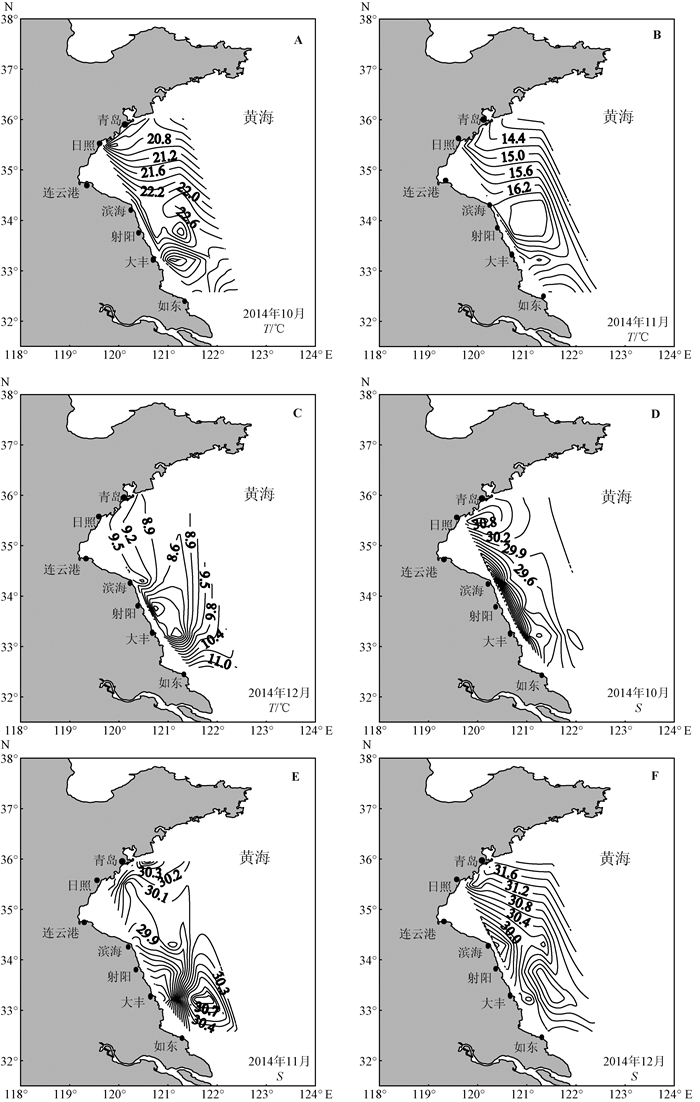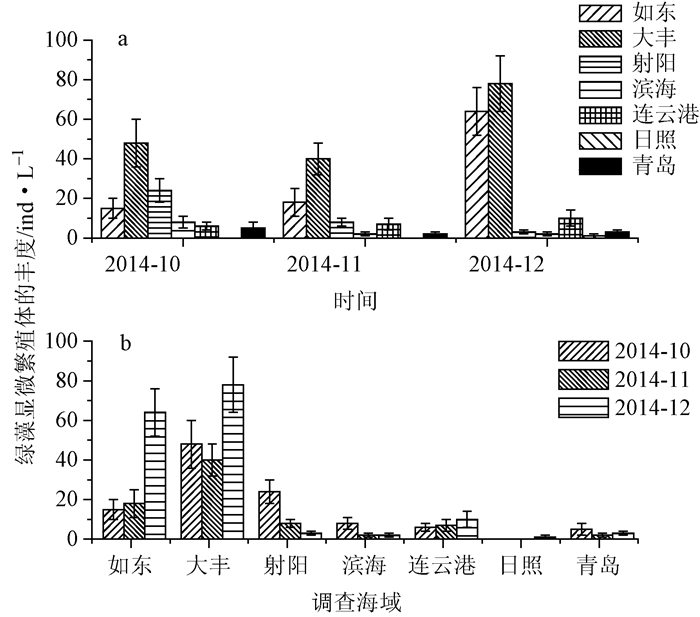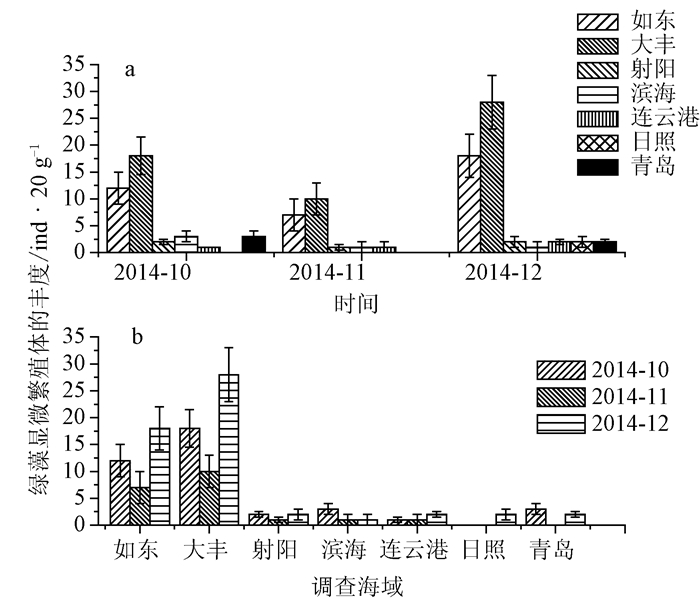Tempo-spatial distribution of green algae micro-propagules in the Yellow Sea after the outbreak of the green tide in 2014
-
摘要:
基于2014年10至12月对黄海西部海域水体与沉积物样品采集及实验室萌发培养实验,探究了绿潮暴发后该海域绿藻显微繁殖体的时空分布特征。结果表明,调查海域绿藻显微繁殖体呈现明显的时空变化特征,总体上,高值区集中在如东及大丰海域,并向北逐渐降低。2014年10月~11月调查海域绿藻显微繁殖体数量变化不明显,然而,12月份,其数量显著增加,尤其在如东及大丰海域。2014年11月如东和大丰海域水样中绿藻显微繁殖体丰度分别为16 ind/L和34 ind/L,12月绿藻显微繁殖体丰度上升至62 ind/L和72 ind/L。2014年11月如东和大丰海域泥样中绿藻显微繁殖体丰度分别为7 ind/L和10 ind/20g,12月绿藻显微繁殖体丰度上升至18 ind/L和28 ind/20g。并且靠近紫菜养殖海域的R1、R2、D2和D3站位绿藻显微繁殖体数量显著升高,12月份,紫菜养殖筏架上已经出现附生绿藻。因此,我们推断紫菜养殖筏架上的附生绿藻释放生殖细胞,可以使该海域绿藻显微繁殖体能以更多的机会度过冬季恶劣的环境,为下年的绿潮暴发提供了物质条件。
Abstract:The monthly surveys were conducted along the west coasts of Yellow Sea during October to December 2014 to study the temporal and spatial distribution features of green algae micro-propagules in water and sediment after the large-scale green tide in Yellow Sea.The results showed that there was an evident temporal and spatial variation of the green algae micro-propagules in the survey area.The high values were presented mainly in Dafeng and Rudong area.The spatial distribution of green algae micro-propagules incread gradually from south to north in the invested area.There was no significant change on the abundance in October and November of 2014.However, it significantly increasd at Dafeng and Rudong area in December.In the coastal water of Rudong and Dafeng, the desenties of green algae micro-propagules in the water were 16 and 34 ind/L, respectively, in November and increased to 62 and 72 ind/L in December.The denseties of green algae micro-propagules in the sediment were 7and 10 ind/20 g, respectively, in November and increased to 18 and 28 ind/20 g in December.As shown in this research, the quantity of green algae micro-propagules significantly increasd at the stations of R1、R2、D2 and D3 near the Pyropia aquaculture area.Feuthermore, green algae attached on the Pyropia aquaculture rafts have appeared in December.Therefore, it was suggested that the micro-propagules released from the green algae attached on the Pyropia aquaculture rafts may survive through the winter, and serve as the seed stock for the following spring bloom.
-
Keywords:
- Yellow Sea /
- green tides /
- green algae /
- micro-propagules /
- Porphyra aquaculture
-
2008年以来,绿潮的暴发已经成为南黄海夏季的一个常态化的海洋灾害[1-2]。快速生长能力、多样化的繁殖增长策略是黄海绿藻能够快速积累生物量并暴发大规模绿潮的主要原因[3]。Huo等[4]报道南黄海海域的营养盐足以支持绿藻的快速生长,并能达到快速生长阶段。营养繁殖和无性繁殖是绿藻两种有效繁殖策略,使绿藻可以在黄海绿潮暴发过程中保持高的生长速率[5-6]。并且,绿藻显微繁殖体的产生和释放在黄海绿潮暴发阶段的生物量快速积累过程中起到了重要的作用[2, 7-8]。
Pang等[9]研究认为绿藻显微繁殖体广泛存在于南黄海近岸海域。Liu等[10]研究认为广泛存在于底泥和水体中的绿藻显微繁殖体将为下年黄海绿潮的暴发提供越冬的“种子库”,并且在春季适宜的环境条件下在南黄海沿岸形成绿潮。方松等[11]研究了南黄海海域绿潮暴发前绿藻显微繁殖体的时空分布状况。Li等[12]研究了绿潮暴发期间绿藻显微繁殖体的时空分布状况。Song等[13]研究了苏北浅滩海域周年的绿藻显微繁殖体的时空分布。先前的研究多集中在绿潮暴发前和暴发期间绿藻显微繁殖体的时空分布,调查区域多集中在江苏近岸海域。为了系统的探究绿潮暴发后绿藻显微繁殖体的时空分布特征,本文在2014年10月~12月,研究绿潮暴发后,黄海西部海域绿藻显微繁殖体数量和时空分布特征。
1 材料与方法
1.1 站位设置
在黄海西部海域设置如东(R1-R5)、大丰(D1-D5)、射阳(S1-S3)、滨海(B1-B3)、连云港(L1-L5)、日照(Z1-Z3)和青岛(Q1-Q5)7条调查断面,射阳和日照设置3个站位,其余每条断面设置5个站位(离岸距离分别为0 km、20 km、40 km、70 km、100 km)。2014年10月~12月期间,每月进行一次航次调查,共计3次。
1.2 调查海域环境参数的测定
以《海洋调查规范》(GB12763.4-2007)为标准,应用RBR温盐深仪(型号:XR-620-CTDTu18550)现场直接测取调查站位的盐度、温度。
1.3 绿藻显微繁殖体样品采集和培养
在每一站位的表层采集1 L海水,海水采集采用HQM-1型有机玻璃采水器,随后用纱绢对海水样品进行过滤。在实验室内,将采集的海水样品分别在两个容量为500 mL烧杯中培养,并做平行样。烧杯在使用前需经过10% HCl浸泡10 h,然后用蒸馏水充分清洗。向培养的海水样品中添加GeO2-VSE,使DIN和PO4-P分别达到500 μmol/L和30 μmol/L。然后将海水样品在光照周期为12 L:12 D藻类培养室或光照培养箱中培养,温度和光照强度分别设置为16~18℃和80~100 μmol/(m2·s)。在培养7 d后,对烧杯中的海水样品进行充气培养,充入的空气需经过CuSO4溶液过滤。在培养期间,每隔5 d对培养溶液补充营养盐。培养3周之后,可以看到有绿藻幼苗长成。这些幼苗是由海水中的绿藻显微繁殖体形成的,此时可以通过统计海水中的绿藻幼苗的数量,确定每升海水中的绿藻显微繁殖体的数量[10]。
每个站位应用采泥器采集表层泥样样品,随机称取每个站位的泥样样品20 g,放于500 mL灭菌的烧杯中,加入灭菌海水400 mL,用玻璃棒充分搅拌,静置15~20 min。然后将烧杯上部较澄清的泥浆转移到另一个灭菌的烧杯中,丢弃掉沉入底部的较大石粒和沙粒。用灭菌的海水补齐500 mL,再次充分搅拌后,将250 mL的培养液转移到另一个已灭菌的烧杯中,随后的培养方法参考海水样品的培养。通过统计培养出的幼苗数量,可以确定20 g泥样中的绿藻显微繁殖体数量。
1.4 数据分析
绿藻显微繁殖体丰度数据均表示为平均值±标准误,并进行ANOVA的方差分析。当p<0.05时,认为存在着显著差异性。
2 结果与讨论
2.1 2014年10月~12月调查海域温度、盐度的变化
在三个航次的调查中,调查海域平均表层海水温度为21.8℃、15.4℃和9.7℃,呈现温度逐渐下降的趋势。如东海域平均表层海水温度为22.6℃、16.8℃和11.2℃。大丰海域平均表层海水温度为22.1℃、16.2℃和10.7℃。从图 2可知,海水温度从北向南逐渐升高。海水盐度变化不显著,范围在29到32之间,呈现从近岸到外海逐渐升高的趋势。
2.2 2014年10月~12月调查海域水样中绿藻显微繁殖体时空分布
2014年10月~12月,调查海域水样中均有不同数量绿藻显微繁殖体存在,密度高值区位于如东和大丰海域。2014年10月~11月,各调查海域除日照海区外,均检测到绿藻显微繁殖体的存在。2014年10月,绿藻显微繁殖体数量最高站位为D3,密度为126 ind/L。2014年11月,调查海区绿藻显微繁殖体数量总体呈下降的趋势,D2站位绿藻显微繁殖体数量最高,密度为50 ind/L。2014年12月,如东和大丰海域绿藻显微繁殖体数量显著升高(p<0.05),尤其靠近紫菜养殖海域的R1、R2、D2和D3站位绿藻显微繁殖体数量显著升高(p<0.05),其它海域绿藻显微繁殖体数量无明显变化;如东海区绿藻显微繁殖体数量由11月份的16 ind/L上升到62 ind/L,大丰海区的绿藻显微繁殖体数量由34 ind/L上升到72 ind/L;密度最高的站位为D2,绿藻显微繁殖体数量达到了186 ind/L。
2.3 2014年10月~12月调查海域底泥中绿藻显微繁殖体时空分布
2014年10月~12月,黄海海域泥样中的绿藻显微繁殖体分布趋势与水样基本一致,密度高值区均集中在如东和大丰海区。如图 3和图 5显示,调查海域北部5个断面(射阳、滨海、连云港、日照和青岛)平均绿藻显微繁殖体数量0~3 ind/20 g,明显低于南部2个断面(大丰和如东)绿藻显微繁殖体数量7~28 ind/20 g;而如东和大丰海域底泥中绿藻显微繁殖体数量又随着时间而发生显著变化,其密度在12月显著升高(p<0.05)。2014年11月如东和大丰海域泥样中绿藻显微繁殖体数量分别为7和10 ind/20 g,12月绿藻显微繁殖体数量上升到18和28 ind/20 g。
前期研究显示,盐度和绿藻显微繁殖体数量之间存在一定关系。Gao等[8]认为盐度是影响绿藻释放显微繁殖体的环境因子之一。王建伟等[14]研究显示,盐度范围在12~32之间,盐度升高可以促进绿藻显微繁殖体释放。然而,本研究中,各个调查海域盐度范围在29~32之间,在10~12月调查期间盐度无明显变化,因此盐度可能不是影响黄海海域绿藻显微繁殖体分布的主要环境因素。
很多研究都证实了温度是影响绿藻显微繁殖体释放及其分布的重要因子[10-12]。王建伟等[14]研究发现浒苔孢子释放最适温度范围在10~35℃。Song等[13]研究显示,温度在10~20℃范围内,绿藻显微繁殖体的萌发率随着温度的升高而升高,而且不同的绿藻种类具有不同的最适萌发温度。我们调查发现,12月份如东和大丰海域表层海水温度为10.6~11.2℃,适宜绿藻释放生殖细胞。12月份紫菜养殖筏架已出现大量附着绿藻,在当时海水温度条件下,附着绿藻可以释放大量生殖细胞[15],对紫菜养殖区及其邻近海域绿藻显微繁殖体起到补充作用。因此,我们认为黄海南部紫菜养殖区及其邻近海域绿藻显微繁殖体的丰度主要受成熟藻体和环境因子的影响,而温度为主要的环境因子。
从本研究的调查结果发现,如东和大丰近岸站位(如R1、R2、D2、D3)水体中绿藻显微繁殖体数量明显高于其他站位,且其密度在12月份显著升高。与黄海南部紫菜养殖筏架的分布比较,R1、R2、D2和D3站位靠近紫菜养殖区。根据紫菜养殖周期,养殖筏架一般于每年9月~10月下海[1],组成筏架设施的梗绳、竹竿等为绿藻显微繁殖体的附着提供了附着基[3]。根据调查,12月份,养殖筏架和缆绳上已有大量绿藻幼苗和成熟藻体存在[15]。这些绿藻可以在一定条件下不断向海区释放生殖细胞包括孢子和配子,使此海域绿藻显微繁殖体数量升高,对繁殖体种群起到补充作用。沉积物中绿藻显微繁殖体的变化趋势与水体中显微繁殖体完全相同,水体中的显微繁殖体可以沉降到底层沉积物中保存。同时黄海南部紫菜养殖海域有着其独特的水文特征,该海区水体较浅,受波浪与潮流的影响较大,涨落潮差可达5 m以上,通过浅地层剖片分析,可见沉积物经常被掀动迹象,水流作用较强,水体搅动剧烈[16-17],巨大的风浪和强大的潮汐流能够扰动沉积物,沉积物中的绿藻显微繁殖体也会随之进入上层水体,补充水体中的绿藻显微繁殖体。如东和大丰海区绿藻显微繁殖体数量在12月份显著升高(p<0.05),使该海域的绿藻显微繁殖体能以更多的数量和机会度过冬季恶劣的环境,为来年绿潮的暴发提供了物质条件。由于11月份如东和大丰海域仍存在一定量的绿藻显微繁殖体,12月份数量显著升高。因此,我们推测:绿潮暴发前期紫菜养殖海域水体和沉积物中一直存在着数量可观的绿藻显微繁殖体来源两部分,一部分主要来自于紫菜养殖筏架上的绿藻释放的生殖细胞包括孢子和配子,另一部分来自于上年遗留的绿藻显微繁殖体。
根据前期研究,绿藻显微繁殖体在低温、低光照条件下可以存活相当长的一段时间,并保持较高的萌发能力[10, 18],在适宜的温度、盐度、光照和营养盐等条件耦合作用下开始萌发生长[13, 19]。Zhang等[20]提出了“显微繁殖体

3 结论
(1) 2014年12月,如东和大丰海域水样和泥样中绿藻显微繁殖体数量显著上升,主要受温度和成体绿藻的影响。
(2) 江苏紫菜养殖筏架上成体绿藻在冬季释放生殖细胞,使该海域绿藻显微繁殖体能以更多的机会度过冬季恶劣的环境,保障了绿潮持续性暴发。
-
-
[1] LIU D Y, KEESING J K, XING Q G, et al.World's largest macroalgal bloom caused by expansion of seaweed aquaculture in China[J].Marine Pollution Bulletin, 2009, 58(6):888-895. doi: 10.1016/j.marpolbul.2009.01.013
[2] LIU D Y, KEESING J K, HE P M, et al.The world's largest macroalgal bloom in the Yellow Sea, China:formation and implications[J].Estuarine, Coastal and Shelf Science, 2013, 129:2-10. doi: 10.1016/j.ecss.2013.05.021
[3] ZHANG J H, HUO Y Z, YU K F, et al.Growth characteristics and reproductive capability of green tide algae in Rudong coast, China[J].Journal of Applied Phycology, 2013, 25(3):795-803. doi: 10.1007/s10811-012-9972-4
[4] HUO Y Z, ZHANG J H, CHEN L P, et al.Green algae blooms caused by Ulva prolifera in the southern Yellow Sea:identification of the original bloom location and evaluation of biological processes occurring during the early northward floating period[J].Limnology and Oceanography, 2013, 58(6):2206-2218. doi: 10.4319/lo.2013.58.6.2206
[5] 叶乃好, 张晓雯, 毛玉泽, 等.黄海绿潮浒苔(Enteromorpha prolifera)生活史的初步研究[J].中国水产科学, 2008, 15(5):853-859. doi: 10.3321/j.issn:1005-8737.2008.05.019 [6] ZHANG X W, XU D, MAO Y Z, et al.Settlement of vegetative fragments of Ulva prolifera confirmed as an important seed source for succession of a large-scale green tide bloom[J].Limnology and Oceanography, 2011, 56(1):233-242. doi: 10.4319/lo.2011.56.1.0233
[7] FU G, YAO J T, LIU F L, et al.Effect of temperature and irradiance on the growth and reproduction of Enteromorpha prolifera J.Ag.(Chlorophycophyta, Chlorophyceae)[J].Chinese Journal of Oceanology and Limnology, 2008, 26(4):357-362. doi: 10.1007/s00343-008-0357-0
[8] GAO S, CHEN X Y, Yi Q Q, et al.A strategy for the proliferation of Ulva prolifera, main causative species of green tides, with formation of sporangia by fragmentation[J].PLoS One, 2010, 5(1):e8571. doi: 10.1371/journal.pone.0008571
[9] PANG S J, LIU F, SHAN T F, et al.Tracking the algal origin of the Ulva bloom in the Yellow Sea by a combination of molecular, morphological and physiological analyses[J].Marine Environmental Research, 2010, 69(4):207-215. doi: 10.1016/j.marenvres.2009.10.007
[10] LIU F, PANG S J, ZHAO X B, et al.Quantitative, molecular and growth analyses of Ulva microscopic propagules in the coastal sediment of Jiangsu province where green tides initially occurred[J].Marine Environmental Research, 2012, 74:56-63. doi: 10.1016/j.marenvres.2011.12.004
[11] 方松, 王宗灵, 李艳, 等.南黄海及长江口附近海域绿潮暴发前期微观繁殖体的动态变化[J].海洋学报, 2012, 34(4):147-154. http://d.old.wanfangdata.com.cn/Periodical/hyxb201204017 [12] LI Y, SONG W, XIAO J, et al.Tempo-spatial distribution and species diversity of green algae micro-propagules in the Yellow Sea during the large-scale green tide development[J].Harmful Algae, 2014, 39:40-47. doi: 10.1016/j.hal.2014.05.013
[13] SONG W, PENG K Q, XIAO J, et al.Effects of temperature on the g ermination of green algae micro-propagules in coastal waters of the Subei Shoal, China[J].Estuarine, Coastal and Shelf Science, 2015, 163:63-68. doi: 10.1016/j.ecss.2014.08.007
[14] 王建伟, 阎斌伦, 林阿朋, 等.浒苔(Enteromorpha prolifera)生长及孢子释放的生态因子研究[J].海洋通报, 2007, 26(2):60-65. doi: 10.3969/j.issn.1001-6392.2007.02.009 [15] HUO Y Z, HUA L, WU H L, et al.Abundance and distribution of Ulva microscopic propagules associated with a green tide in the southern coast of the Yellow Sea[J].Harmful Algae, 2014, 39:357-364. doi: 10.1016/j.hal.2014.09.008
[16] 易俊陶, 黄金田, 宋建联.对盐城市沿海2008年浒苔发生情况的初步认识[J].海洋环境科学, 2009, 28(S1):57-58. http://www.cnki.com.cn/Article/CJFDTotal-HYHJ2009S1015.htm [17] WANG J F, JIANG P, CUI Y L, et al.Molecular analysis of green-tide-forming macroalgae in the Yellow Sea[J].Aquatic Botany, 2010, 93(1):25-31. doi: 10.1016/j.aquabot.2010.03.001
[18] SANTELICES B, HOFFMANN A J, AEDO D, et al.A bank of microscopic forms on disturbed boulders and stones in tide pools[J].Marine Ecology Progress Series, 1995, 129:215-228. doi: 10.3354/meps129215
[19] SOUSA A I, MARTINS I, LILLEBO A I, et al.Influence of salinity, nutrients and light on the germination and growth of Enteromorpha sp.spores[J].Journal of Experimental Marine Biology and Ecology, 2007, 341(1):142-150. doi: 10.1016/j.jembe.2006.09.020
[20] ZHANG J H, HUO Y Z, WU H L, et al.The origin of the Ulva macroalgae blooms in the Yellow Sea in 2013[J].Marine Pollution Bulletin, 2014.89(1/2):276-283. http://www.wanfangdata.com.cn/details/detail.do?_type=perio&id=c6644ca07d3f6fed075b32a34f82b178
[21] TAYLOR R, FLETCHER R L, RAVEN J A.Preliminary studies on the growth of selected 'green tide' algae in laboratory culture:effects of irradiance, temperature, salinity and nutrients on growth rate[J].Botanica Marina, 2001, 44(4):327-336.
[22] 张华伟, 马家海, 胡翔, 等.绿潮漂浮浒苔繁殖特性的研究[J].上海海洋大学学报, 2011, 20(4):600-606. http://d.old.wanfangdata.com.cn/Periodical/shscdxxb201104019 [23] 陈群芳, 何培民, 冯子慧, 等.漂浮绿潮藻浒苔孢子/配子的繁殖过程[J].中国水产科学, 2011, 18(5):1069-1076. http://www.wanfangdata.com.cn/details/detail.do?_type=perio&id=zgsckx201105012 [24] LIU F, PANG S J, XU N, et al.Ulva diversity in the Yellow Sea during the large-scale green algal blooms in 2008-2009[J].Phycological Research, 2010, 58(4):270-279. doi: 10.1111/pre.2010.58.issue-4
-
期刊类型引用(0)
其他类型引用(4)





 下载:
下载:




